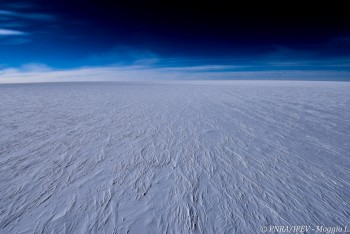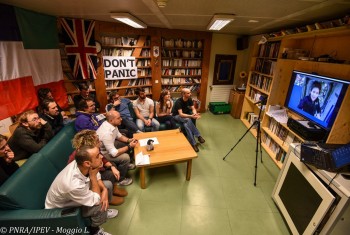On 8 April 2015, 17:00 local time, the atmosphere in the living room of Concordia station is electric. The crew prepared for this moment, by arranging sofas, positioning cameras and carefully hanging our national flags (Europe, Italy, France, UK and Switzerland). Mario Salza, the stationleader, refreshes his introductory speech while performing a final check of the audio-video signal. Our skeleton team of thirteen people here for the winter, of which I am one, take a seat in front of the webcam in tense anticipation.
At 9:30 GMT Greenwich mean time, as used on the International Space Station or 17:30 local time at our part of Antarctica, the computer starts ringing. It is Houston mission control and a couple of minutes later ESA astronaut Samantha Cristoforetti appears on our screen. We are onboard the International Space Station, 400 km above our head! It is a paradox that the Space Station is actually our closest Antarctic neighbor. The Russian team who live at Vostok station, 600 km south west of us, are further away than Samantha in space!
We are delighted to see the first female Italian astronaut weightless hair but even more her smile, kindness and positive, open attitude. We are happy to find her in excellent shape and, as she says herself, she is well adapted to the space environment.
We greet each other with a rush of emotions, remembering our previous encounter in Cologne last October. We met her on the last day of our training at ESA’s Europrean Astronaut Centre. When we met her in Germany she was saying farewell to the ESA team who had trained and prepared her for her Expedition 42/43 Futura mission. In recognition of our future challenges in Concordia, Antarctica and hers on the International Space Station, in Earth orbit, we cheered together and held a present of hers, a small piece of tissue with the motto: “DON’T PANIC!”.
Mario briefly introduces our french-italian-english-swiss at Concordia, better known as DC11 – Dome C 11th overwintering crew. He continues to introduce the station and summarises the scientific and logistic activities taking place here. Samantha then takes us on a tour through the modules of the International Space Station. During the tour we meet her colleagues: the american Terry Virts and the russian Anton Shkaplerov. We discuss physiological adaptation, technical solutions for waste recycling, food, science. We feel close as we are both part of extreme missions that are important for mankind to understand our planet and its inhabitants while pushing boundaries towards new horizons.
What do such different environments have in common? The Internatioanl Space Station is circling Earth 400 km above while Concordia station is only 3.2 km above sea level but 4000 km from the nearest city and more than 15000 km from Europe. Why does ESA conduct human biology and medicine research on astronauts in space as well as on the “hivernauts” at Concordia?
 ESA does not call Concordia “White Mars” without a reason. Concordia is a “space analogue” meaning that the environmental, social and professional conditions as well as logistics experienced by the winter crew are the closest on Earth to those experienced by astronauts during a long-duration space flight.
ESA does not call Concordia “White Mars” without a reason. Concordia is a “space analogue” meaning that the environmental, social and professional conditions as well as logistics experienced by the winter crew are the closest on Earth to those experienced by astronauts during a long-duration space flight.
But let’s go back to Samantha. While it had been exciting talking to her and sharing experiences, she had put aside one last breath-taking surprise for us… she turns the webcam round in the Cupola observatory so it faces outer space. Together with Samantha we face the window and like curious children stare outside in wonder, towards the Sun, our star, which is rising, lighting up Earth’s curvature. Our planet down there, a tiny rotating spheroid in the universe. It would be fantastic to look at the Space Station passing by at 28000 Km/h in the sky of Concordia and greet each other, but unfortunately the space outpost does not fly far enough south for us to see it.
 Living on the Space Station, Samantha experiences sixteen sunrises, or sixteen days, in 24 hours. At Concordia, as we live without sunrise for many months, we feel as if we are living one long day in the year. 26 April is Samantha’s birthday, I think that celebrating your birthday in space or in Antarctica is a milestone memory that will stay with anybody for the rest their lives.
Living on the Space Station, Samantha experiences sixteen sunrises, or sixteen days, in 24 hours. At Concordia, as we live without sunrise for many months, we feel as if we are living one long day in the year. 26 April is Samantha’s birthday, I think that celebrating your birthday in space or in Antarctica is a milestone memory that will stay with anybody for the rest their lives.
We would all like to thank you NASA and ESA for this wonderful opportunity.
Lorenzo Moggio






Discussion: 3 comments
Thank you ! to read about your encounter is stimulating and revealing.
I enjoyed it very much, thank you again for shearing. Like The little Prince … Samantha live 16 many sunsets as well as 16 sun rises … I love that !!! ♡ It makes me wonder!!! Bless you all.
Thank you, Lorenzo, a fascinating read.
I’m bookmarking this blog for regular visits – and passing the URL on to a friend who, having visited Antarctica (in Summer…) has a better idea than I do of the conditions you are experiencing.
I think you are amazingly brave – I can only look on open mouthed with admiration!
respect to all of you who endure the extremes in the name of science, it did not realize yous would need intense training to even go out there so reading these blogs and seeing that use got to converse with the Italian Astronaut is just special so hats off to you guys